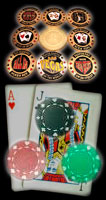VALUE OF DRAWS
This hand illustrates a concept that’s become known as Morton’s theorem, named after a poker player who died in a motorcycle accident shortly after he popularized the concept in the Internet newsgroup rec poker.
My version of his concept is slightly modified from his original idea: When many hands with draws are competing on the flop against a semi-strong made hand, the primary beneficiary of flop bets is the best draw, not the best hand.
This concept is not well known and often misunderstood.
Many players seem to think that the implication is that you should play your big cards and big pairs very aggressively to drive out all the marginal poker draws.
That’s correct in tight games and some typical games, but that’s not the correct interpretation when the game loosens up.
In a loose game, the idea of starting with the best hand goes out the window, draws start getting value. That’s the important concept of Morton’s theorem.
This concept is illustrated by the table on page 160.
For various numbers of callers, the table gives the combined outs, which collectively make the best pair an underdog to the field.
In all forms of poker, it’s very important to get your money in the pot when your hand is best.
The idea of “when your hand is best ” needs to be extended beyond thinking of poker as a game of hand domination or a struggle between a made hand a draw.
In Holdem, your hand is best when the odds that you will win the pot are greater than the odds you are getting from the number of active hands that will call a bet.
Play on the flop is very much a game of pot odds. A manipulation perspective is also important, but in some situations you’ll want to manipulate players to call.
This is fundamentally important concept in Holdem, and the looser the game conditions, the more important the concept.
NUMBER OF OUTS
|
Number of collective outs to make an overpair a money underdog by number of opponents |
|
Number of outs |
Number of opponents |
14 |
1 |
20 |
2 |
24 |
3 |
26 |
4 |
28 |
5 |
29 |
6 |
31 |
7 |
32 |
8 |
Pick the Right Table / Picking a Seat / Theories of Poker / Betting Theory: The Odds
A Theory of Starting Hand Value
A Theory of Flop Play: Counting Outs and Evaluating Draws
The Dynamics of Game Conditions / Table Image / Player Stereotypes
Women and Poker / Spread-Limit Games / Double Bet on the End Games / Kill Games
Short-handed Games / Tournaments / No-limit and Pot-Limit Poker



